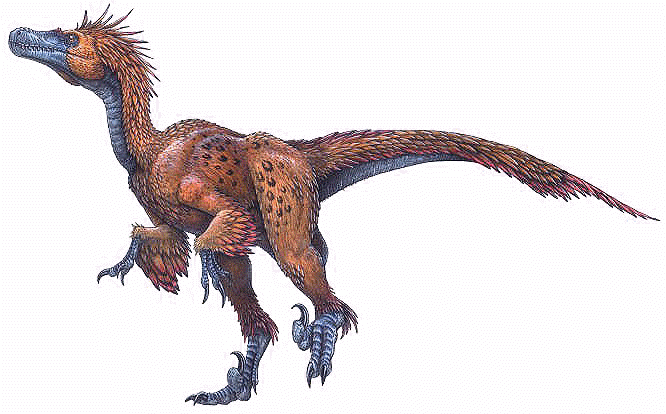|
Deinonychus was a spectacular, but fairly
small dinosaur. It was a fast and vicious hunter. Its name means
"terrible claw," and it was given this name because of the large,
retractable hunting claw on each of its feet. Like its cousin, the
Velociraptor, it used this claw to tear into the flesh of the
dinosaurs it hunted. The claw would snap forward and make a large,
deep wound when it attacked. Deinonychus was about twice as big
as
Velociraptor. Shed teeth and several specimens of
Deinonychus were found with the skeleton of a large plant eating
dinosaur, Tenontosaurus. Some authorities maintain that
this established that they hunted in packs, ones capable of bringing
down animals much larger than themselves.
Deinonychus belongs to a family of dinosaurs called
dromaeosaurs. They all share the same characteristics a lightly built
skull with sharp backwardly curved teeth, elongated arms and hands
with sharp claws, and an extraordinary sickle-like second toe claw
which was carried raised off the ground to protect the sharp point.
Dromaeosaurs probably had keen vision and their brains were relatively
large for a dinosaur. The dromaeosaurs lived throughout the Cretaceous
period, 140 to 65 million years ago.
In his 1986 book The Dinosaur Heresies, Dr. Robert Bakker puts
forth the view that Deinonychus has many features found in
birds and might be considered either a bird-like dinosaur or a
dinosaur-like bird. Recent research and discoveries by scientists such
as Dr. Philip Currie are showing that some dinosaurs similar to
Deinonychus most likely had feather-like coverings on all or part
of their bodies. These proto-feathers were most likely used for
insulation, display, or both, and may eventually have evolved into
flight feathers. To date, these have not been found on Deinonychus.
Several hundred Deinonychus bones were discovered by
paleontologist John Ostrom and Grant E. Meyer in 1964 in southern
Montana John Ostrom named and described Deinonychus, and
the discovery of this clearly active, agile predator did much to
change the scientific (and popular) conception of dinosaurs and open
the door to speculation that dinosaurs may have been warm-blooded.
Several years later, Ostrom noted similarities between the hand of
Deinonychus and birds, which led him to revive the hypothesis
that birds are descended from dinosaurs. Thirty years later, this idea
is almost universally accepted. Finds of related dinosaurs from China,
such as Sinornithosaurus and Microraptor indicate that
this dinosaur probably bore feathers. Other relatives include
Velociraptor, Utahraptor, and Dromaeosaurus.
Deinonychus is probably the best known
of the dromeasaurids as nine specimens have been discovered A skeleton
of Deinonychus can be seen on display at the American Museum of
Natural History or the Harvard Museum of Comparative Zoology. The
American Museum and Harvard specimens are from a different locality
than the Yale specimens which Ostrom described, and the claws are
different shapes (Ostrom 1976). This raises the possibility that the
two are, in fact, different species or even different genera.
|
![]()
